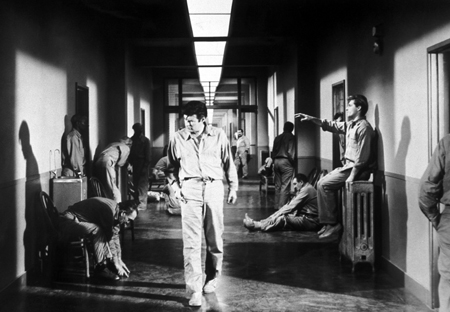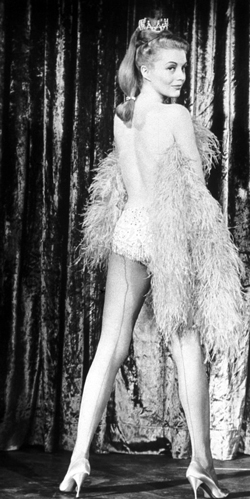
 |
|
|
|
Sam Fuller's soaring critical reputation was begun by French critics in the 1950s. They saw him as the perfect cinema auteur, a director whose work was an ongoing evolution of personal themes and a personal style. Entering the industry by demonstrating his ability to knock out story ideas and scripts extremely fast, Fuller obtained his directing break via the low-budget producer Robert Lippert. They made a pile of money with his tough-as-nails Korean War picture, The Steel Helmet. Maintaining a fierce independence, Fuller worked for a few years for Darryl Zanuck at Fox, but then had to step down to ever-smaller budgets on non- front rank pictures distributed by Fox, RKO and Columbia. 1962's Merrill's Marauders, a much bigger Warners production, failed to reboot his big-screen career. Almost any Fuller film from the '50s is a jolting experience. A strong personality with a style developed from experience working on tabloid newspapers, Fuller has little interest in traditional Hollywood glamour and finesse. Much of I Shot Jesse James plays out in intense, claustrophobic close-ups. His movies are packed with personal views on Cold War politics and his love of American journalism. The petty crooks of Pickup on South Street refuse to play ball with the cops and the F.B.I., but they also hate Communists. The visuals in a Sam Fuller film can be seductive (Pickup's erotic opening subway scene) or politically audacious (Mt. Fuji framed between the boots of a dead American soldier in House of Bamboo) but they're always direct and unsubtle. French critics celebrated Fuller's style as pure cinema and later critics dubbed it with the term "Cinema Fist". Critic Andrew Sarris pegged him as "an authentic American primitive". This brings us to a pair of independent Sam Fuller dramas made back-to-back in 1963. The first was filmed on a ten-day shooting schedule with scarcely more resources than an early Roger Corman production. If any film fits the criteria of auteur critics, Shock Corridor is it. Fuller directed, wrote the script and cast many of the roles with actors he'd worked with before. The picture takes place on only five or six interior sets, one of which was designed by the art director of Children of Paradise, Eugène Lourié. Shock Corridor may be Fuller's most extreme picture, a chaotically radical statement about American madness. 
With the help of his editor and a friendly psychiatrist (Philip Ahn), reporter Johnny Barrett (Peter Breck of Verboten!) has himself committed to an asylum. He hopes to learn the truth about an unsolved murder in the psycho ward, and write a story that will earn him a Pulitzer Prize. Johnny's steady girl Cathy, who works as a striptease singer (Constance Towers) cooperates only because she's afraid of losing his love: she tells the police that she is Johnny's sister, and that he is incestuously obsessed with her. The scheme works, and Johnny is installed in the asylum with dozens of real mental cases. Although the doctors sincerely want to cure their charges, the ward itself is not conducive to mental health -- when Johnny becomes irritable and unmanageable, he's forced to undergo shock treatment. Three patients witnessed the murder, and Johnny slowly gets them to say the name of the guilty party. Stuart (James Best) is a victim of brainwashing in Korea, and thinks he's a Civil War general. Trent (Hari Rhodes) is a black man but preaches white supremacy. And nuclear scientist Boden (Gene Evans of The Steel Helmet and Park Row), unable to face the consequences of his discoveries, has reverted to a six year-old mentality. Cathy is horrified to discover that Johnny's personality is disintegrating but he refuses to call off the hoax ... even when he experiences strange hallucinations, and begins to lose his ability to speak! It's no wonder that Sam Fuller became a god to the French New Wave, as the director's overall approach to filmmaking seems intent on breaking cinema down into its basic building blocks. When measured against conventional feature work Shock Corridor often appears to be borderline incompetent. The first dialogue scene establishes the overall hysterical tone. Four people in a room take turns shouting reams of exposition about Johnny's planned undercover mission. Everybody talks like Sam Fuller, loading their sentences with literary and Bible allusions, often two to a sentence. Emotional and shallow, Fuller's dramatic style seems a psychological outgrowth of his comic-book action films of the 1950s. Most of the acting is overacting, albeit pitched at a consistent level of hysteria. Peter Breck twists himself into a pretzel to perform Johnny's constantly changing moods. Fuller frequently thrusts the anguished faces of Breck and Constance Towers into the camera. None of it is believable but it's all of a piece. The movie comes off as a series of crazy exaggerations of "normal" dramatic scenes. The three witnesses (Hari Rhodes, James Best & Gene Evans) deliver excellent work; we're only made uncomfortable by Fuller's schematic, cliché-based conception of the mentally ill. To illustrate his thesis that America is a Looney Bin, Fuller populates the asylum with a pack of overacting freaks. 
Ploys to keep the audience off-balance serve only to heighten the air of artificiality. Cathy sings a sensitive torch song while performing a vulgar strip act. Her costumed figure is later superimposed in miniature over the sleeping Johnny, taunting him. Johnny is bombarded by irrational patients, outbursts of violence and the overreactions of the ward attendants. Remove any of us from our comfort zone, and we'll crack up. Fuller uses the asylum as a microcosm of an America haunted by topical psychoses -- the imperative to succeed, forbidden sex, the threat of Communism, racial injustice and nuclear annihilation. The difference between Sam Fuller and other "message" filmmakers is that Fuller writes in bold headlines, not subtle subtext. His memorable combat films aim right for disturbing issues other filmmakers won't touch. When he leaps into the civic debate, he's like the proverbial bull in a china shop, too brash to be believed. Some quieter moments with Hari Rhodes and Gene Evans are actually touching, and players Frank Gerstle (a desk cop) and Chuck Roberson (a ward attendant) show admirable restraint. But more typical is the wild miscalculation of the scene where Johnny mistakenly walks into a room containing a number of dazed, melancholy women that pace about singing weakly. Just when we're thinking that this must be the dreaded Tennessee Williams ward, Fuller cuts to a close-up of Johnny's horror stricken eyes: "Nymphos!" This cues Johnny being mauled and scratched within an inch of his life by a pack of raving harpies. Even if one has so far suppressed the urge to laugh at Shock Corridor, this goes over the edge. The disc's extras tout the endless corridor set by art director Lourié as a marvelous piece of visual trickery. It might be, if Fuller didn't show it so often. After the second cut it is obvious that the far stretch of hallway is occupied only by a pair of midgets that continually pace back and forth, no matter what the scene. Worse, Fuller spoils the designer's forced-perspective illusion by shifting his camera from the center line, revealing the corridor to be exactly what it is, a foreshortened set with a flat painting at the rear to continue the perspective to the vanishing point. Otherwise, the cinematography of Stanley Cortez (The Night of the Hunter) serves Sam Fuller well. Rooms are flat-lit but all of the character close-ups are carefully modeled, in keeping with the director's emphasis on aberrant psychology. The asylum setting almost justifies this lack of continuity -- it's not unusual for Fuller to cut directly from a flat-lit medium shot of an actor, to a close-up with heavy dramatic lighting. Fuller and his collaborators do pull off one terrific effect with the corridor set, when Johnny hallucinates that it is awash with rain from a thunderstorm. This kind of delirious expressionism, providing a visual correlative to Johnny's growing insanity, was rare in American films of the time. 
Shock Corridor may be crude and rude, but it is the work of genuine artist, a rare director who was able to make films that express his personal identity. Fuller had to give up ownership of the film and never saw his money from the producers, but in the long run Shock Corridor helped make his reputation. We think he got the better of the deal. Criterion's Blu-ray of Shock Corridor is a perfect transfer of this low-budget B&W production, with widescreen framing that focuses our attention away from ceilings and floors of Fuller's cheap sets. The added sharpness shows the film's budget (as when solid walls shake like sets from an old Monogram picture) but also lets us see the details that Fuller spent his money to achieve, such as the expert fantasy superimposures of Cathy caressing Johnny's sleeping face, like a seductive Barbie doll. The film becomes even more eccentric when Fuller pops to squeezed color for two more asylum hallucinations, featuring 16mm footage he filmed while location hunting in Japan and South America a decade before. Disc producer Susan Arosteguy fashions an attractive package of extras. Tim Robbins, Quentin Tarantino, Jim Jarmusch and Martin Scorsese are on-screen for a 1996 documentary about Fuller's career, The Typewriter, the Rifle and the Movie Camera. Actress Constance Towers appears in a lengthy interview. She talks about her work with Fuller on Shock Corridor and The Naked Kiss, as well as her entire career story up to and through her time working for John Ford. A trailer is included as well for the film's 1965 Allied Artists' release. The insert booklet contains an essay by Robert Polito and some anecdotal excerpts from Fuller's autobiography A Third Face. The appropriately cartoonish disc illustration artwork is by Daniel Clowes.
On a scale of Excellent, Good, Fair, and Poor,
Shock Corridor Blu-ray rates:
Reviews on the Savant main site have additional credits information and are often updated and annotated with reader input and graphics. Also, don't forget the 2010 Savant Wish List. T'was Ever Thus.
Review Staff | About DVD Talk | Newsletter Subscribe | Join DVD Talk Forum |
| ||||||||||||||||||